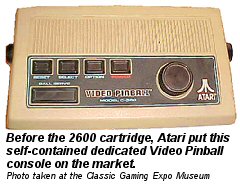 The Game: Pull the plunger back and fire the ball into play. The more bumpers it hits, the more points you rack up. But don’t let the ball leave the table – doing so three times ends the game. (Atari, 1979)
The Game: Pull the plunger back and fire the ball into play. The more bumpers it hits, the more points you rack up. But don’t let the ball leave the table – doing so three times ends the game. (Atari, 1979)
Memories: Having done Basketball and Football as successful video games, Atari turned its attention to other sports and other balls…so to speak. One such experiment was the not-quite-successful Video Pinball, the company’s attempt to bring the excitement and physics of pinball to the video screen.
The game’s dazzling disco-era look was the result of the video display being generated backward by a monitor laying flat inside the cabinet. The monitor’s display was then reflected toward the player by way of a half-silvered mirror with the overlay decal attached. The result was that the video display now magically shined through the artwork. (The animation seen here shows a rough approximation of the screen as seen in the arcades, the actual video display, and the artwork overlay that made things a bit more colorful.) This was actually a very common trick in early arcade games: Space Invaders used it, and so did many others right into the 1980s…until processing power increased enough for most games to generate their own backgrounds.
 Atari was sure enough about the game, however, to market home versions of it – both as a standalone unit in the style of its dedicated home Pong and Stunt Cycle games, and as an Atari VCS cartridge. Despite lacking the super-freaky background artwork of the arcade version, the cartridge is a better game. The arcade game limits you to a handful of targets – as many as its circuitry could generate and keep track of while still offering anything even remotely resembling the real physics of pinball – and two sets of flippers. The VCS cartridge demonstrates greater computing power (!) by giving you a wide array of targets.
Atari was sure enough about the game, however, to market home versions of it – both as a standalone unit in the style of its dedicated home Pong and Stunt Cycle games, and as an Atari VCS cartridge. Despite lacking the super-freaky background artwork of the arcade version, the cartridge is a better game. The arcade game limits you to a handful of targets – as many as its circuitry could generate and keep track of while still offering anything even remotely resembling the real physics of pinball – and two sets of flippers. The VCS cartridge demonstrates greater computing power (!) by giving you a wide array of targets.
 Many video games came and went in the 1970s, perhaps the most experimental stage in video game evolution there was. But while many sports and themes (i.e. invasion from outer space) are timeless, others aren’t. Few 70s games scream “70s” at you like Atari’s Video Pinball.
Many video games came and went in the 1970s, perhaps the most experimental stage in video game evolution there was. But while many sports and themes (i.e. invasion from outer space) are timeless, others aren’t. Few 70s games scream “70s” at you like Atari’s Video Pinball.
